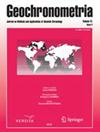Secular Variations of Inclination of the Geomagnetic Field in SE Poland Between 1200 and 1800 AD
IF 0.9
4区 地球科学
Q3 Earth and Planetary Sciences
引用次数: 1
Abstract
Abstract A set of brick samples from 26 historical buildings in SE Poland was taken for archeomagnetic study. As a result of this study, the secular variations of inclination of the geomagnetic field from 1200 to 1800 AD were defined for SE Poland. The course of them is approximately the same as obtained in other parts of Europe. The only remarkable difference is a more rapid and deeper drop of inclination noted in SE Poland at the end of the 18th century. The regional curve of secular variations of inclination for SE Poland differs substantially from the coeval curve defined earlier for N Poland (Gdańsk) in their segments dated at the first half of the 18th century, where a deep minimum of inclination was disclosed in the bricks from N Poland only. The reuse of medieval bricks for the construction of objects giving this minimum or later secondary heating of original bricks can be a reason for the difference observed. Further archeomagnetic studies of the bricks of the last millennium are necessary in SE Poland to eliminate the gaps and uncertainties in the regional curve of secular variations of inclination.公元1200年至1800年间波兰东南部地磁场倾角的长期变化
摘要:从波兰东南部的26座历史建筑中采集了一组砖样进行考古地磁研究。据此,确定了波兰东南部1200 ~ 1800年地磁场倾角的长期变化。它们的过程与欧洲其他地区的大致相同。唯一显著的区别是,18世纪末波兰东南部的倾斜度下降得更快、更深。波兰东南部的长期倾角变化区域曲线与波兰北部(Gdańsk)在18世纪上半叶的区段中定义的同期曲线有很大不同,其中仅在波兰北部的砖块中发现了深的最小倾角。中世纪砖在建筑中的重复使用,使原始砖的二次加热降到最低或更晚,这可能是观察到的差异的一个原因。为了消除长期倾角变化的区域曲线中的空白和不确定性,有必要对波兰东南部过去一千年的砖块进行进一步的考古地磁研究。
本文章由计算机程序翻译,如有差异,请以英文原文为准。
求助全文
约1分钟内获得全文
求助全文
来源期刊

Geochronometria
地学-地球科学综合
CiteScore
2.20
自引率
0.00%
发文量
1
审稿时长
>12 weeks
期刊介绍:
Geochronometria is aimed at integrating scientists developing different methods of absolute chronology and using them in different fields of earth and other natural sciences and archaeology. The methods in use are e.g. radiocarbon, stable isotopes, isotopes of natural decay series, optically stimulated luminescence, thermoluminescence, EPR/ESR, dendrochronology, varve chronology. The journal publishes papers that are devoted to developing the dating methods as well as studies concentrating on their applications in geology, palaeoclimatology, palaeobiology, palaeohydrology, geocgraphy and archaeology etc.
 求助内容:
求助内容: 应助结果提醒方式:
应助结果提醒方式:


